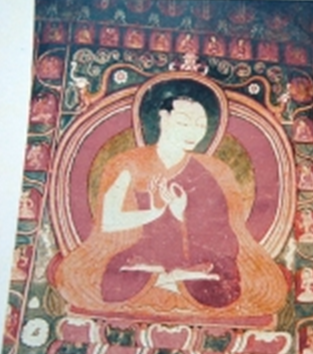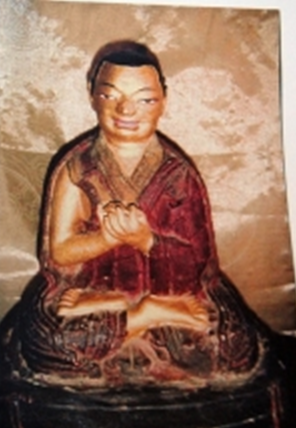Rinchen Zangpo
This is a collection of articles archived for the excellence of their content. Readers will be able to edit existing articles and post new articles directly |
Rinchen Zangpo
Rinchen Zangpo and his contribution to Buddhism
By Zain Ul Aabedin Aabedi, Friday, August 2, 2013
Leh: It was Lotsava Rinchen Zangpo, who contributed a lot for the cause of Buddhism in Ladakh. He was born at Guge of western Tibet. He received early monastic education at Guge (Province) itself. However, at the same time Buddhism was improving its position in Tibet. Tho-ling monastery was emerging as a centre of Tibetan Buddhism. Under the patronage of Lha-lama Yeshes-Od the second phase of Buddhism started. He selected twenty one young students, Rinchen Zangpo and others to study Buddhism deeply and sent them to Kashmir. But except Rinchen Zangpo and Legspa Sherab all of them died without having achieved their goal.
In Kashmir he studied Buddhism under learned Buddhist scholar viz Yogi Ratnasiddhi, Pandit Gunamitra, Shraddakara Varman, Boddhashri, Naropa, Pandit Kamala Gupta etc. Thereafter he translated 161 books from Sanskrit to Tibetan. These include eighteen treatises on the Sutra and Tantra of Kangyur, thirty-three works of commentary on Sutra and 110 treatise of commentary of Tantras. Among these, fourteen works were exclusively translated by him and, rest 147 works; he collaborated with other Lotsavas (translator) and Indian translators. The penetration of Buddhism into Ladakh is closely connected with Rinchen Zangpo (958-1055). He founded many shrines in Ladakh. Popular among them are: Nyarma Lhakhang, Alchi, Mangyu, Sumdha,Basgo,Saspol Chorten, Pethub, Ney temple, Kyungam Chorten, Sakti chorten, Mane Sermo of Leh, Chiktan, Singge-sgang Lamayuru, Teri, Wanla, Atitse, Thagyun-lakhang Saboo, Narchung, Tashis gang, Ahinsa, Garatong, Kilibuk, Gangles Choskor, White and red temple of Hunder,etc.
There are many temples which are equally important in the propagation of Buddhism. These temples were built during 11th century A.D. Some of them are as follows:
1. Ruins east of Basgo village
2.Rgyamtsa ruins north of Leh
3.Mundhig Lhakhang Kharbu
4. Lhakhang Gogpo Wakha
5. Chigtan Lakhang and Nyarma Lhakhang Thiksay. In the 10th century, a powerful kingdom was formed in western Tibet known as Guge, covering Guge, Purang, Ladakh, Zangskar and Spiti (Petech1997) Guge’s Buddhist king sponsored the propagation of Buddhism by constructing temples and monasteries and sponsoring scholarly activities. Tabo monastery in Spiti, regarded as the oldest continuously operating Buddhist monastery in India and the Himalayas, was built during this time (Klimburg-Salter 1997).
As a result indigenous ‘Bon’ practitioners were converted to Tibetan Buddhism (Ibid) Some of the notable scholars and spiritual adepts produced during these periods include a throne holder of Galden monastery: Dhangkar paldan Gyaltsan, Rangrik Rinchen Kungga Gyatso, Lopon Yeshes Tsettan, Khenpo Gyatso and many others who earned the title of Kachen and Geshe, which is considered to be equivalent to a Doctorate in Buddhist Philosophy (Tsering 2000). It is not out of place to mention here that Nyarma was an important place throughout Ladakh during that time. Lha-lama Yeshes-Od established a monastic University there and students from Nubra, Zangskar, Baltistan, Purig, Lahaul-Spiti, lower Ladakh and Changthang and western Tibet were enrolled there for higher Buddhist studies.
Rinchen Zangpo was made the Head and Administrator of the University. There was great hustle and bustle at Nyarma. Besides Pali and Sanskrit Bhoti language was the medium of instruction. But the University could not last long, due to political and financial crises it could not function and continue for a long time. A popular statue “Dorjay Chhenmo” was also shifted to Ladakh’s capital Shey, and the importance of Nyarma decreased day by day. The closure of the University was really unfortunate for the Ladakhis. The later Ladakhi kings failed to support the institution to grow. May it would have continue to function as a university, during Lhachen dynasty of Ladakh, there might have no need of proceeding the lamas to Lhasa for centuries together for higher studies’. Because the Ladakhi would have a centre of Buddhist learning at Nyarma itself, wherefrom we could have produce Buddhist scholars and most learned persons, like Kachen and Geshes. As a result Ladakhis were deprived of social, cultural, moral, spiritual and religious education for centuries together. The Lakhangs built by Rinchen Zangpo and ruins of other important buildings are still there, which witnesses the significance of the site. But nothing has been done for its preservation from any quarter.
2.The Alchi temple is a living heritage of Ladakh built by Rinchen Zangpo. Its Murals, Thankas, Statues, Paintings and Mandalay are worth-seeing. Its vast artistic and architectural heritage testifies to the importance given to the arts in Ladakhi way of life. This is really a source of inspiration for the Buddhist of Ladakh. To construct and decorates this buildings Rinchen Zangpo recruited artists and craftsmen from Kashmir, which one can witness even today.
From the above details we understand that Rinchen Zangpo wholly dedicated his services in the propagation of Buddhism. His most productive period was between 989-999 A.D, when he not only founded temples and choskhors, but also headed the whole establishment of scholars and translators. Rinchen Zangpo met the great Buddhist tantaric scholar and Siddha, Naropa (956-1040A.D.) at the later’s retreat at Phullahari in the northen Kashmir and received instructions on meditation on Mahamudra. He visited Ladakh and blessed the present side of Lamayuru monastery. This monastery claims to be the oldest monastery in ladakh. The oldest building here called Singge Sgang is attributed to Rinchen zangpo. Naropa spent some time in Zongkhul monastery in Zangskar as well as Ati-tse. The two caves around which the present monastery has developed are said to have been used by Naropa for solitary meditation.
Buddhist scholar Pandit Atisha arrived in Tibet in 1043 A.D. and at the same time went to Tho-ling monastery. Here, he met Rinchen Zangpo and was very much impressed by his scholarly knowledge of Buddhism. When Rinchen Zangpo called him in his meditation room, he saw Rinchen Zangpo’s separate seats for meditating the different Buddhist deities. Then he thought that he reached here at the right time; and asked Rinchen zangpo, “why do you have separate seats for meditating different deities, can you meditate all of them through one seat?” He later advised him not to meditate deities separately but to meditate them at one seat. Rinchen Zangpo later improved his method of meditation and according to the advice of Pandit Atisha he started meditation. Soon after, this meditation process came to Ladakh and Buddhist scholars, who believed Kadampa sect, followed his method of meditation.
Rinchen Zangpo also introduced the astrology and Amchi system of treatment in ladakh. The Ladakhi Amchis have preserved the medicine book prepared by Lotsava Rinchen Zangpo. To conclude the topic, we may say that Rinchen Zangpo was a great translator. The Ladakhis pay too much regards and respect towards him, for his translation of a great number of Indian texts, many of which continue to be widely read today, but also for his establishing many temples and monasteries, reputedly 108 altogether. Among his monasteries Alchi in Ladakh, Tabo in Spiti and Tholing in western Tibet are still in good condition.

